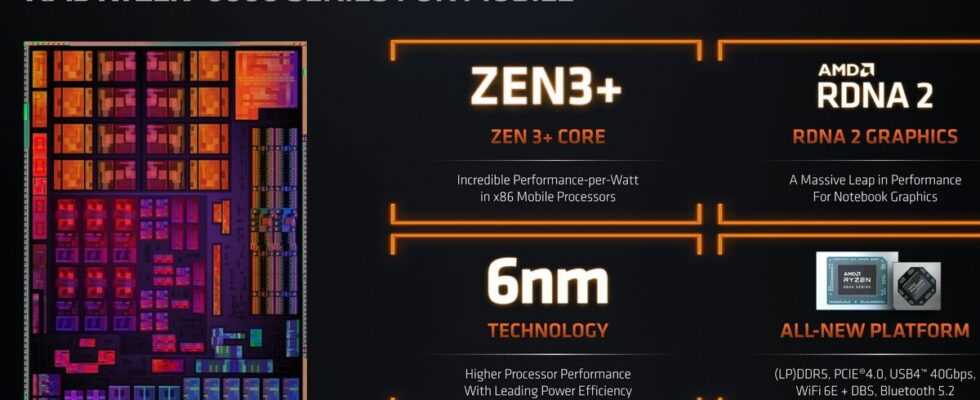5
Announced at CES 2022, AMD Ryzen 6000 mobile processors will gradually find their way into spring laptops. The opportunity to come back to the different areas of improvement brought by the Zen 3+ and RDNA 2 architectures that compose them.
AMD took advantage of CES to draw the outlines of what will make up its 2022 offer in terms of laptop processors: the Ryzen 6000. This series will target all markets, from entry-level to high-end via chips. for computers gaming or vested in creation. These chips will mix iGPU revolution and CPU optimization.
While most of AMD’s partners are on the starting blocks to offer their laptops mounted in Ryzen 6000, the chip manufacturer wanted to tell us more about the developments brought by this generation of processors. Apart from the information that we had already echoed during the announcements made at CES, we particularly note the emphasis that was placed on the energy management of the processor part and on the performance of the integrated graphics part.
Quite pompously, AMD promises computers capable of milling for 24 hours without needing an electrical outlet. Clumsy communication as AMD’s test conditions are so far from reality: screen at 150 nits, wifi and Bluetooth disabled and playback of a video stored on the machine. In reality, it is more interesting to rely on the 17% autonomy gain announced in video playback compared to the 5000 series. This gain should already make it possible to exceed 11 to 12 hours of autonomy on our test protocol (screen over 200 nits, wifi and Bluetooth active and streaming video playback).
To gain these few hours of autonomy, AMD has reviewed the fineness of engraving which goes from 7 to 6 nm, but also several points in its processor architecture – called Zen 3+ – in order to manage the frequency of each core even more finely. . We also note the arrival of optimizations relating to the management of screens integrated into laptops, making it possible to better manage their cooling, and therefore their electricity consumption. Finally, AMD is also introducing its PMF technology, which offers the possibility of changing the energy profile completely automatically depending on the task performed. A point that we saw in an article dedicated to this subject.
The platform used to manage these Ryzen 6000s is renewed to support the latest standards. The network thus goes to wifi 6E and Bluetooth 5.2, PCIe 4 makes its arrival, as does support for DDR5 / LPDDR5 – a first at AMD. Finally, another first, USB4 will also be fully supported, enough to take advantage of a lot of new features such as 40 Gb / s speed, support for 8K screens, charging via USB-C for a maximum of 240 W , 4K at 60 fps with HDR, and of course a whole lot of compatible USB docks.
AMD does not ignore artificial intelligence and now offers hardware acceleration of ambient noise cancellation effects. A demonstration was made to us, and, indeed, the system makes it possible to guard against unpleasant sound surprises during videoconferences in particular. A system that is reminiscent of RTX Voice at Nvidia, a feature now integrated into the GeForce RTX Broadcast package.
For the iGPU part, AMD is finally turning the page on the aging Vega architecture in favor of the RDNA 2 architecture used on the desktop Radeon RX 6000s, but also in the iGPU of game consoles from Sony (PS5), Microsoft ( Xbox Series X) and Valve (Steam Deck). Enough to augur a nice leap in terms of graphics performance, AMD notably promising a doubling of speeds in games compared to the Ryzen 5000 (U series at 15 W). Not enough, however, to exceed the performance of a dedicated entry-level graphics card.
The Nvidia GeForce GTX 1650 Max-Q thus remains ahead of the Radeon 680M – the iGPU that will be found in the Ryzen 9 and 7 – if we refer to the tests carried out by AMD. Tests which also make it possible to situate the absolute level of performance: on recent games, the speed remains around 45 fps on average in Full HD, with details set to their minimum. However, AMD has more than one trick up its sleeve and puts forward the argument of FSR and RSR, which raise the speed to more than 60 fps on the same panel of games – but at the expense of image quality, it must be admitted. The Ryzen 5 Radeon 660M will target Nvidia’s GeForce MX450, overtaking it or staying behind depending on the case. In short, nothing very exciting in the end, but enough to “troubleshoot” for online games like Fortnite, Dota 2 Where Counter-Strike: Global Offensivefor example.
This increase in performance is obviously due to the architectural advances offered by RDNA 2, but also to that of three complementary reinforcement axes. The use of 6 nm fine engraving firstly allows the operating frequency to rise to a maximum of 2.4 GHz on the Radeon 680M, and up to 1.9 GHz on the Radeon 660M. Added to this is the presence of a maximum of 768 computing units, when the Ryzen under Vega were limited to 512 units. Finally, the arrival of support for DDR5 type RAM also makes it possible to benefit from a marked increase in bandwidth – memory bandwidth being essential for iGPUs.
The first laptops with AMD Ryzen 6000 processors were announced a few weeks ago, including machines for gaming based on Ryzen 6000HS. The HX and U versions will be integrated into the chassis of AMD partners from March. We will offer you the test of these new features as soon as possible.

